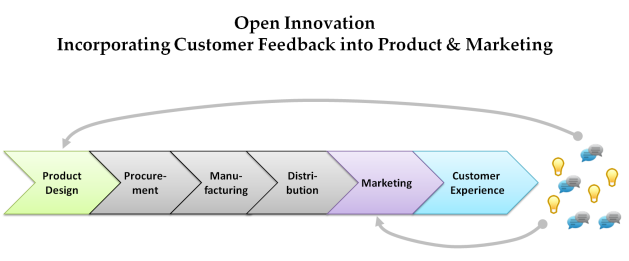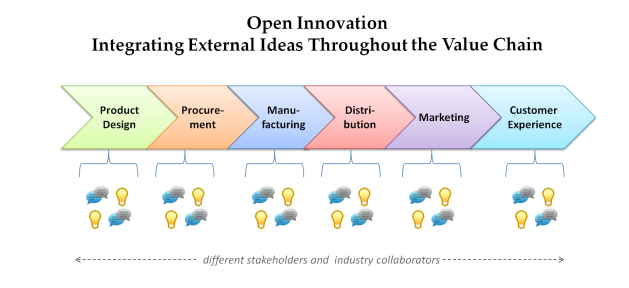Beyond Social CRM: The Open Innovation Revolution
August 25, 2010 11 Comments
The idea of bringing customers into the process of defining the products and service of your organization is one that is gaining a lot of steam. One manifestation of that is the increased interest in Social CRM. In this scenario, companies engage their social customers for feedback and marketing purposes. Taking it a step further, Mark Tamis and Esteban Kolsky see the higher purpose as organizing the business around the newly social customers.
And then there’s Stefan Lindegaard.
Stefan is a leading open innovation consultant and author of the recently published book, The Open Innovation Revolution. He sees things advancing even further. From page 13 of his book:
Open innovation is about integrating external partners in the entire innovation process. This should happen not just in the idea or technology-development phase but also in all other phases toward market acceptance. User-driven innovation is great because it directs your innovation efforts toward market needs. Open innovation takes you to the next step by providing more opportunities through external partners as you address those market needs.
Stefan is on to something. To illustrate his point, I put together these two graphics, based on a hypothetical product delivery value chain. The first graphic might be properly termed, “lightweight open innovation”:
 Here’s where Stefan sees the (r)evolution of this:
Here’s where Stefan sees the (r)evolution of this:
That’s quite a feat there, isn’t it? Incorporate a greater range of external input throughout your company’s innovation process. As Stefan describes it on page 12:
User-driven is highly related to open innovation, but it has to go further to become open innovation. This happens when you not only get ideas from external sources but also let external players become key players in the process of turning ideas into a business.
The Value of Open Innovation
And what is the value of taking open innovation to a more integrated, advanced level? Procter & Gamble illustrates the benefit. In 2000, P&G CEO A.G Lafley set a goal of having 50% of the company’s products derived from external sources. To accomplish this, the company consciously engaged external parties through its Connect + Develop initiative. Through Connect + Develop, P&G conducted a two-way exchange of ideas and feedback with industry, leveraging a dedicated staff of over 50 people. The results?
- In 2000, the success rate of new products was 15-20%. By 2008, the new product success rate rose to between 50 – 60%. (pdf)
- R&D investment as a percentage of sales is down from 4.8% in 2000 to 3.4% in 2006. (link)
The company attributes its success to its open innovation model. And the advantage continues. Diversified, globally-based P&G’s stock price is up 7% over the past 5 years, while the diversified, globally-based businesses of the S&P 500 are down 2%. That’s a 9 percentage point spread.
P&G sees a key benefit of its ambitious open innovation model as this: to be the preferred partner of choice when external parties have a good idea. Think about that. The volume of good ideas that can occur outside your organization is significant. When individuals, academics and industry players do have these ideas, who’s at the top of their mind for partnering? That’s a significant, sustainable competitive advantage.
The Open Innovation Revolution looks at a number of aspects companies need to address to integrate open innovation more fully into their company’s processes.
It Starts with a Vision and Planning
The initial steps are crucial for establishing an open innovation strategy. Stefan observes that you only get “one-and-a-half chances to do this thing right”. So what are the key considerations for organizations considering open innovation?
- Establish a clear mandate, a strong strategic purpose and an ideation theme
- Conduct a stakeholder analysis
- Develop a communication strategy
- Build a common language
- Include organizational approaches that achieve TBX (T = top; B = bottom; X = across)
- Strive to be innovative instead of working to become innovative
His book addresses each of those elements. He also includes examples of companies (often Danish) incorporating these steps.
The step that most resonated with me is the first one, establish a clear mandate. When this is done, it moves the initiative from an interesting suggestion to an approach supported culturally, with processes, management buy-in and identified key players.
But it’s also the hardest and is less amenable to bottom-up experimentation. I say that as someone who has read the value of bottom-up viral adoption and experimentation in the Enterprise 2.0 world. If an organization is going to engage external parties in the co-creation, co-development process, you’d better make sure you’ve got legal and senior management signed-on.
And Stefan emphasizes the issues that will be faced internally at companies as they seek to establish their open innovation mandate. A favorite term of mine is “corporate antibodies”. These are the people inside an organization that will seek to sabotage an open innovation initiative. Why?
They don’t see the effort as 2+2=5. For them, it’s 2+2=2
Essentially they fear having their own projects derailed, and potentially losing their power inside the organization. This is where senior management needs to push the effort, and even crack a few skulls if needed. Here’s how Stefan relates it (page 32):
Mads Clausen, former CEO at Danfoss, was very good at taking managers aside and looking them straight in the eye while telling them that he really believed in this innovation initiative and that he hoped the manager shared his approach.
Innovation leaders must also educate executives on open innovation and, more importantly, must make the consequences of executive decisions very clear.
In Chapter 8 of the book, Stefan addresses strategies for overcoming corporate antibodies.
People, Networking, Roadblocks, Personal Brand and Time Management
Throughout the rest of The Open Innovation Revolution, Stefan discusses a variety of elements that factor into open innovation success.
With people, he has identified two archetypes: innovation leaders and intrapreneurs. Innovation leaders work at the strategic and tactical level to build the internal platform to handle open innovation. Intrapreneurs work at the operational level on initiatives. Key questions he answers are: how to identify and develop these people?
With networking, he applies concepts of social network analysis. And spends some time talking about how you individually can go about your networking. Networking’s value is in finding new ideas and connecting with people globally, and even internally.
Roadblocks include the corporate antibodies, but other issues as well. Top executives may not “get” open innovation. Also, radical innovation is too high a threshold to seek.
Personal brand is a useful term, and one that immediately puts some people off. One interesting tidbit Stefan notes is that establishing a personal brand is seen as manipulative in many countries, but “less so in the United States.” In the chapter discussing personal brand, he includes some worksheets to help you think about your own.
Time management is no doubt an issue for most of us. He includes Parkinson’s Law, which I hadn’t heard of but immediately recognized as true: “Work expands so as to fill the time available for its completion.” He provides advice and frameworks for better managing time.
Admittedly, the personal branding and time management sections weren’t quite my cup of tea. But my guess is they reflect conversations he’s had over the years with many employees of companies who are figuring out open innovation. For example, remember his note that Europeans and the rest of the world outside the U.S. are reticent about this personal branding thing.
Start Thinking about Open Innovation
An area which I’d like to see more is a description of how open innovation works operationally. For instance, do you have existing personnel lead the interactions with external parties? Or is it better to have external connectors lead the coordination? What are the intellectual property issues to be considered? What are the contractual models for sharing the benefits of the effort?
Perhaps this is fodder for a future book by Stefan. But as it is, The Open Innovation Revolution is a smart, rich introduction to the concepts underlying this emerging practice. Stefan knows his stuff, and readers will come away with a better sense of how to prepare their organization, and themselves, for the coming revolution.
I’m @bhc3 on Twitter, and I’m a Senior Consultant with HYPE Innovation.


The Conversation